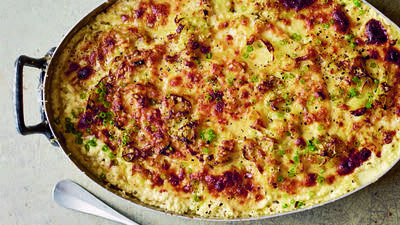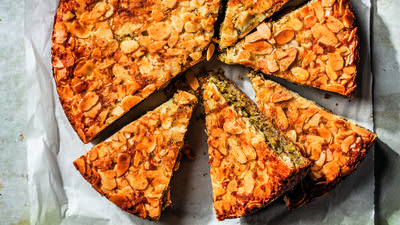
(Law of Peanut Butter and Jelly)
Gear
skillet
blender
vessel for chilling the mousse
pastry bags or zip-top bags
stand mixer with dough hook attachment
small pot
rubber spatula
medium bowl, buttered
heating pad
Dutch oven or heavy-bottomed pot
candy thermometer
sheet pans
rolling pin
4-inch ring cutter or pint-sized glass
spider or tongs chopstick (optional)
fine-mesh sieve
Ingredients
Foie gras mousse:
8 ounces foie gras grade B, roughly chopped
About 15 green seedless grapes
2 shallots, finely diced
1 tablespoon Cointreau, or other orange liqueur
2 teaspoons kosher salt
1/4 cup heavy cream
Dough:
1/2 cup very warm water
1/4 cup granulated sugar
2 teaspoons active dry yeast
4 tablespoons (1/2 stick) unsalted butter
3 cups all-purpose flour, plus more for dusting
1 teaspoon kosher salt
1/4 teaspoon ground cinnamon
2 large eggs, lightly beaten
Doughnuts:
Vegetable oil, for frying
1/2 cup grape jelly
1 tablespoon kosher salt, for sprinkling
1/4 cup confectioners’ sugar, for dusting
If I’m to be remembered for anything past my expiration, I think the foie gras doughnut might be my greatest accomplishment. It all started when I was seeing a girl who worked in the pastry department of a restaurant. We would have little tiffs about food and cooking. One of these was over which bread is “the king of breads.” She argued for brioche, while I said fry breads. She temporarily won, citing that brioche accompanies the king of meats, foie gras. I swore that if I ever figured out how to make doughnuts, I’d put foie gras in a doughnut and serve it, proving once and for all that fry breads are the king of breads.
Some time and some girlfriends later, I opened Do or Dine. At that time, there was one person on the floor and two people in the kitchen. I was running food as I cooked it. I ran out to a silver-haired man and his beautiful wife and daughter, put the food down, my apron a mess, and explained the dish. In a Jean Reno accent, he asked me what my plans were for zis kitchen. I said I wanted to do a lot of things, but mostly I wanted to get the recently opened doughnut shop up the street (called Dough) to make me blank doughnuts that I could fill with foie gras. The man asked me what I would do wif zis. I said I’d sell them. He said, “Well, I am Dough.” I couldn’t believe how happily the fates smiled on me. I shook his hand, took his number, and before I could call, he was bringing me samples of hole-less doughnuts to fill. The problem was, I had never cooked with foie, only eaten it, so I didn’t have any idea where to begin. I went to a specialty store and purchased some foie gras mousse. I ran back to the restaurant to pipe it into the blank doughnuts. I knew it needed a fruity jam to balance the richness and savoriness, but because I was impatient, I sent someone to get it for me. They came back with Welch’s grape jelly, which I piped in right away, planning on substituting a fancy jam down the road. I salted the top of the doughnut, then hid the salt in confectioners’ sugar. It looked like a normal jelly doughnut. I bit into it. The rich foie was put into overdrive by the sweetness, but tempered by the slight tang of the Concord grape jelly. The dough was light and fluffy. It was a four-star dish disguised as a jelly doughnut. I finally won the fight, at least in my own mind.
Some people came to take the doughnut’s picture. Then some people claimed they invented the foie gras doughnut first. Then some people protested online. But it wasn’t just some people, it was hundreds. Somehow we got an e-mail every time someone signed the petition, so we were missing e-mails from suppliers and employees with our inboxes flooded. I set up a filter to collect the protest e-mails. Eventually we had well over a thousand e-mails. I took a screen shot and sent it to the press. A war began. Everyone wanted to know why thousands of people were up in arms over a little doughnut. We made international news, and the little joint, cobbled together by or for friends in Bed-Stuy, cemented its tiny place in New York City dining history. Here you can make your own controversy, homemade, or you can just go buy the components and assemble them like I do at the restaurant.
Make the foie gras mousse. Put the foie in a skillet over very low heat. Once some fat has rendered and pooled, about 3 minutes, add the grapes and shallots to the skillet. Cook until the shallots soften and the foie begins to melt and darken in color, about 5 minutes. Add the Cointreau and cook for 1 minute more.
Carefully pour the hot mixture into a blender with the salt. Then, with the blender running on the lowest speed, very carefully and slowly pour in the cream and increase the speed to high until combined. (The mousse at this stage will be very loose—it will set when refrigerated.)
Transfer the mousse to another vessel and chill in the fridge, uncovered, until cool to the touch. Pour or scrape the chilled mousse into a plastic bag or disposable pastry bag with no tip. Tie or seal the bag and allow to chill in the refrigerator until completely cool, at least 1 hour.
Make the dough. Activate the yeast by adding the sugar and warm water to the bowl of a stand mixer fitted with the dough hook attachment, then sprinkle in the yeast. Cover the bowl with a towel and let sit until the yeast has foamed up, about 10 minutes.
Meanwhile, in a small pot over low heat, melt the butter, then set aside to cool slightly.
In a separate bowl, whisk together the remaining dry ingredients.
Once the yeast has foamed up, add the dry ingredients to the stand mixer bowl and slowly combine with the dough hook. Using a rubber spatula, scrape down the sides. Continue kneading the dough on low, then gradually add the butter, then add the beaten eggs one-half at a time. Once the dough is uniform, turn it out onto a clean, floured work surface and knead just until smooth, about 10 turns, but not too much, or it will begin to toughen.
Place the dough in a buttered bowl and cover with plastic wrap. Let rise in the bowl on a heating pad set to low until doubled in size, about 1 hour.
Flip the risen dough out onto a floured surface, knead once, and regrease the bowl. Flip the dough back into the regreased bowl and cover with plastic wrap. Let the dough rise on the heating pad once again until doubled, about 1 hour more.
Make the doughnuts. Fill a Dutch oven halfway with vegetable oil, clip on a candy thermometer, and bring the oil to 350 F over medium heat. Lightly flour a sheet pan. Line another sheet pan (or plate) with paper towels or use a cooling rack.
Place the dough on a clean floured work surface. Using a rolling pin, very gently roll out the dough to a thickness of . inch. Cut out circles of the dough with a pint-size glass or ring cutter. (You might be inclined to reroll the scraps, but the doughnuts produced from rerolled dough will be tough.) Place the circles onto the floured sheet pan, cover with a clean kitchen towel, and let rise for at least 10 minutes. Make sure to moniter your oil so that it does not overheat.
When the oil is to temperature, and working in batches, drop the doughnuts into the hot oil and fry until risen on one side, about 1 minute, then flip and cook the other side for another minute. Use a spider to remove them from the hot oil, then land on the paper towel– or rack-lined sheet pan (or plate). Allow to cool slightly.
Bag it up! Transfer the jelly to a pastry bag or zip-top bag.
HOLD IT? The mousse can be made in advance and held for up to a week. I highly recommend making this in advance, as the dough requires attention. The last thing you want is to be staring at your dough while the foie is in flames or vice versa. The dough must be fried immediately after its third rise. From there, the doughnuts can be held for up to 6 hours before they show signs of deterioration. If you want hot doughnuts after you have cooked them, reheat the oil, but this time to 375 F. Fry the precooked doughnuts for just a moment on each side, then land on a rack or paper towel–lined plate. Fill the doughnuts. If your doughnuts are hot, use a twice-folded paper towel to hold the doughnut, then stick a knife or chopstick in the side of the doughnut to create a tunnel. Cut the tip of the bag and pipe the foie gras mousse into the hole until the doughnut feels full and heavy. Next, pipe in some of the jam, allowing it to dribble out of the doughnut. Set the doughnut back on the rack, sprinkle with a tiny pinch of salt, and, using a fine-mesh sieve or shaker, dust with confectioners’ sugar.
PLATE IT! Whatever you do, don’t serve this with a knife and fork. It’s a freaking doughnut. Pick it up and eat it, or tear off a bite for your friend. Every blessing has its curse, and people eating doughnuts with a knife and fork is mine. And it happens ALL THE TIME.
CHEAT IT! You can create this entire dish with already made ingredients, or with a combination of homemade and premade ingredients. Foie gras mousse is available frozen online! If you have a doughnut shop that you love, I’ll bet your bippy that they’ll be happy to sell you some unglazed, unholed doughnuts for your filling pleasure. If they aren’t happy to do that, remind them that you will pay full price for less work on their part. Then fill them with foie and sell them at five times what you paid for them directly in front of their store.
BREAK IT: Thanksgiving doughnuts! Use cranberry sauce. Get herbaceous with some parsley, sage, and marjoram in the mousse. Mix the mousse with torn toasted bread, until softened. Chop this up, and pipe the foie-stuffing into the doughnuts.
From The Laws of Cooking by Justin Warner, Flatiron Books 2015.
Before you go...
Each week, The Splendid Table brings you stories that expand your world view, inspire you to try something new, and show how food connects us all. We rely on your generous support. For as little as $5 a month, you can have a lasting impact on The Splendid Table. And, when you donate, you’ll join a community of like-minded individuals who love good food, good conversation, and kitchen companionship. Show your love for The Splendid Table with a gift today.
Thank you for your support.
Donate today for as little as $5.00 a month. Your gift only takes a few minutes and has a lasting impact on The Splendid Table and you'll be welcomed into The Splendid Table Co-op.



